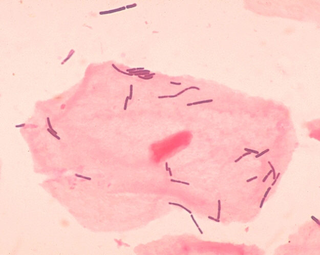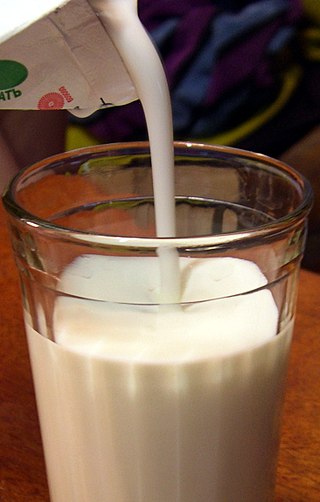
Lactic acid is an organic acid. It has a molecular formula CH3CH(OH)COOH. It is white in the solid state and it is miscible with water. When in the dissolved state, it forms a colorless solution. Production includes both artificial synthesis as well as natural sources. Lactic acid is an alpha-hydroxy acid (AHA) due to the presence of a hydroxyl group adjacent to the carboxyl group. It is used as a synthetic intermediate in many organic synthesis industries and in various biochemical industries. The conjugate base of lactic acid is called lactate. The name of the derived acyl group is lactoyl.

Sourdough or sourdough bread is a bread made by the fermentation of dough using wild lactobacillaceae and yeast. Lactic acid from fermentation imparts a sour taste and improves keeping qualities.

Lactobacillus is a genus of gram-positive, aerotolerant anaerobes or microaerophilic, rod-shaped, non-spore-forming bacteria. Until 2020, the genus Lactobacillus comprised over 260 phylogenetically, ecologically, and metabolically diverse species; a taxonomic revision of the genus assigned lactobacilli to 25 genera.

Lactobacillus bulgaricus is one of over 200 published species in the Lactobacillus genome complex (LGC) and is the main bacterium used for the production of yogurt. It also plays a crucial role in the ripening of some cheeses, as well as in other processes involving naturally fermented products. It is defined as homofermentive lactic acid bacteria due to lactic acid being the single end product of its carbohydrate digestion. It is also considered a probiotic.

Lactococcus lactis is a gram-positive bacterium used extensively in the production of buttermilk and cheese, but has also become famous as the first genetically modified organism to be used alive for the treatment of human disease. L. lactis cells are cocci that group in pairs and short chains, and, depending on growth conditions, appear ovoid with a typical length of 0.5 - 1.5 µm. L. lactis does not produce spores (nonsporulating) and are not motile (nonmotile). They have a homofermentative metabolism, meaning they produce lactic acid from sugars. They've also been reported to produce exclusive L-(+)-lactic acid. However, reported D-(−)-lactic acid can be produced when cultured at low pH. The capability to produce lactic acid is one of the reasons why L. lactis is one of the most important microorganisms in the dairy industry. Based on its history in food fermentation, L. lactis has generally recognized as safe (GRAS) status, with few case reports of it being an opportunistic pathogen.
Lactiplantibacillus plantarum is a widespread member of the genus Lactiplantibacillus and commonly found in many fermented food products as well as anaerobic plant matter. L. plantarum was first isolated from saliva. Based on its ability to temporarily persist in plants, the insect intestine and in the intestinal tract of vertebrate animals, it was designated as a nomadic organism. L. plantarum is Gram positive, bacilli shaped bacterium. L. plantarum cells are rods with rounded ends, straight, generally 0.9–1.2 μm wide and 3–8 μm long, occurring singly, in pairs or in short chains. L. plantarum has one of the largest genomes known among the lactic acid bacteria and is a very flexible and versatile species. It is estimated to grow between pH 3.4 and 8.8. Lactiplantibacillus plantarum can grow in the temperature range 12 °C to 40 °C. The viable counts of the "L. plantarum" stored at refrigerated condition (4 °C) remained high, while a considerable reduction in the counts was observed stored at room temperature.

Bacillus coagulans is a lactic acid–forming bacterial species first isolated and described in 1915 by B.W. Hammer at the Iowa Agricultural Experiment Station as a cause of an outbreak of coagulation in evaporated milk packed by an Iowa condensary. Separately isolated in 1935 and described as Lactobacillus sporogenes in the fifth edition of Bergey's Manual of Systematic Bacteriology, it exhibits characteristics typical of both genera Lactobacillus and Bacillus; its taxonomic position between the families Lactobacillaceae and Bacillaceae was often debated. However, in the seventh edition of Bergey's, it was finally transferred to the genus Bacillus. DNA-based technology was used in distinguishing between the two genera of bacteria, which are morphologically similar and possess similar physiological and biochemical characteristics.

Lacticaseibacillus caseiis an organism that belongs to the largest genus in the family Lactobacillaceae, a lactic acid bacteria (LAB), that was previously classified as Lactobacillus casei-01. This bacteria has been identified as facultatively anaerobic or microaerophilic, acid-tolerant, non-spore-forming bacteria. The taxonomy of this group has been debated for several years because researchers struggled to differentiate between the strains of L. casei and L. paracasei. It has recently been accepted as a single species with five subspecies: L. casei subsp. rhamnosus, L. casei subsp. alactosus, L. casei subsp. casei, L. casei subsp. tolerans, and L. casei subsp. pseudoplantarum. The taxonomy of this genus was determined according to the phenotypic, physiological, and biochemical similarities.

Lacticaseibacillus rhamnosus is a bacterium that originally was considered to be a subspecies of L. casei, but genetic research found it to be a separate species in the L. casei clade, which also includes L. paracasei and L. zeae. It is a short Gram-positive homofermentative facultative anaerobic non-spore-forming rod that often appears in chains. Some strains of L. rhamnosus bacteria are being used as probiotics, and are particularly useful in treating infections of the female urogenital tract, most particularly very difficult to treat cases of bacterial vaginosis. The species Lacticaseibacillus rhamnosus and Limosilactobacillus reuteri are commonly found in the healthy female genito-urinary tract and are helpful to regain control of dysbiotic bacterial overgrowth during an active infection. L. rhamnosus sometimes is used in dairy products such as fermented milk and as non-starter-lactic acid bacterium (NSLAB) in long-ripened cheese. While frequently considered a beneficial organism, L. rhamnosus may not be as beneficial to certain subsets of the population; in rare circumstances, especially those primarily involving weakened immune system or infants, it may cause endocarditis. Despite the rare infections caused by L. rhamnosus, the species is included in the list of bacterial species with qualified presumed safety (QPS) status of the European Food Safety Agency.

Lactobacillales are an order of gram-positive, low-GC, acid-tolerant, generally nonsporulating, nonrespiring, either rod-shaped (bacilli) or spherical (cocci) bacteria that share common metabolic and physiological characteristics. These bacteria, usually found in decomposing plants and milk products, produce lactic acid as the major metabolic end product of carbohydrate fermentation, giving them the common name lactic acid bacteria (LAB).

The Lactobacillaceae are a family of lactic acid bacteria. It is the only family in the lactic acid bacteria which includes homofermentative and heterofermentative organisms; in the Lactobacillaceae, the pathway used for hexose fermentation is a genus-specific trait. Lactobacillaceae include the homofermentative lactobacilli Lactobacillus, Holzapfelia, Amylolactobacillus, Bombilactobacillus, Companilactobacillus, Lapidilactobacillus, Agrilactobacillus, Schleiferilactobacillus, Loigolactobacillus, Lacticaseibacillus, Latilactobacillus, Dellaglioa, Liquorilactobacillus, Ligilactobacillus, and Lactiplantibacillus; the heterofermentative lactobacilli Furfurilactobacillus, Paucilactobacillus, Limosilactobacillus, Fructilactobacillus, Acetilactobacillus, Apilactobacillus, Levilactobacillus, Secundilactobacillus, and Lentilactobacillus, which were previously classified in the genus Lactobacillus; and the heterofermentative genera Convivina, Fructobacillus, Leuconostoc, Oenococcus, and Weissella which were previously classified in the Leuconostocaceae.
Levilactobacillus brevis is a gram-positive, rod shaped species of lactic acid bacteria which is heterofermentative, creating CO2, lactic acid and acetic acid or ethanol during fermentation. L. brevis is the type species of the genus Levilactobacillus (previously L. brevis group), which comprises 24 species (http://www.lactobacillus.ualberta.ca/, http://www.lactobacillus.uantwerpen.be/). It can be found in many different environments, such as fermented foods, and as normal microbiota. L.brevis is found in food such as sauerkraut and pickles. It is also one of the most common causes of beer spoilage. Ingestion has been shown to improve human immune function, and it has been patented several times. Normal gut microbiota L.brevis is found in human intestines, vagina, and feces.
Sakacins are bacteriocins produced by Lactobacillus sakei. They are often clustered with the other lactic acid bacteriocins. The best known sakacins are sakacin A, G, K, P, and Q. In particular, sakacin A and P have been well characterized.

Kefir is a fermented milk drink similar to a thin yogurt or ayran that is made from kefir grains, a specific type of mesophilic symbiotic culture. It is prepared by inoculating the milk of cows, goats, or sheep with kefir grains.

Latilactobacillus sakei is the type species of the genus Latilactobacillus that was previously classified in the genus Lactobacillus. It is homofermentative; hexoses are metabolized via glycolysis to lactic acid as main metabolite; pentoses are fermented via the Phosphoketolase pathway to lactic and acetic acids.
Limosilactobacillus pontis is a rod-shaped, Gram-positive facultatively anaerobic bacterium. Along with other Lactobacillus species, it is capable of converting sugars, such as lactose, into lactic acid. Limosilactobacillus pontis is classified under the phylum Bacillota, class Bacilli, and is a member of the family Lactobacillaceae and is found to be responsible for the fermentation of sourdough, along with many other Lactobacillus species. This microorganism produces lactic acid during the process of fermentation, which gives sourdough bread its characteristic sour taste.
Lactobacillus kefiranofaciens is a species of slime-forming, homofermentative, rod-shaped lactic acid bacteria first isolated from kefir grains, hence its name. Its type strain is WT-2B. Its genome has been sequenced. Lactobaccillus kefiranofaciens was first identified in 1967 in Russia through studying kefir granules. Lactobaccillus kefiranofaciens is part of the lactobacillus genus and firmicutes phylum of bacteria. These bacterium metabolize carbohydrates and produce lactic acid, which can be useful in fermentation. Two subspecies have been identified as kefirgranum and kefiranofaciens, which share properties such as being gram-positive, facultatively anaerobic, and rod-shaped.L. kefiranofaciens is the subspecies related to kefir granules. Studies have investigated the origins and causes for variation in kefir composition and led to conflicting results. Some studies indicate the presence of L.kefiranofaciens was due to geographical location, while others indicate it was due to the different milks used.
Weissella kimchii is a Gram-positive bacterium from the genus of Weissella which has been isolated from fermented cassava from Ketou in Benin.
Limosilactobacillus vaginalis is a lactic acid bacterium that is a normal, but infrequent part of the vaginal microbiome.
Lacticaseibacillus is a genus of lactic acid bacteria.










